1995 HONDA ODYSSEY lock
[x] Cancel search: lockPage 4 of 240
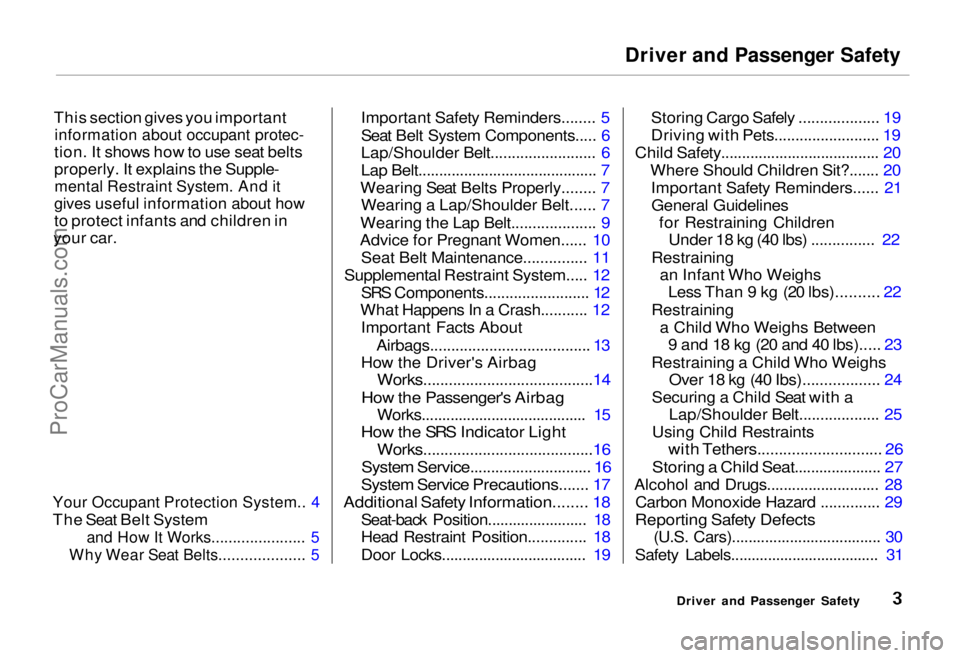
Driver and Passenger Safety
This section gives you important
information about occupant protec-
tion. It shows how to use seat belts
properly. It explains the Supple-
mental Restraint System. And it
gives useful information about how
to protect infants and children in
your car.
Your Occupant Protection System.. 4
The Seat Belt System
and How It Works...................... 5
Why Wear Seat Belts.................... 5
Important Safety Reminders........ 5
Seat Belt System Components..... 6
Lap/Shoulder Belt......................... 6
Lap Belt........................................... 7
Wearing Seat Belts Properly........ 7 Wearing a Lap/Shoulder Belt...... 7
Wearing the Lap Belt.................... 9
Advice for Pregnant Women...... 10
Seat Belt Maintenance............... 11
Supplemental Restraint System..... 12 SRS Components......................... 12
What Happens In a Crash........... 12
Important Facts About
Airbags...................................... 13
How the Driver's Airbag
Works........................................14
How the Passenger's Airbag
Works........................................ 15
How the SRS Indicator Light
Works........................................16
System Service............................. 16
System Service Precautions....... 17
Additional Safety Information........ 18
Seat-back Position........................ 18
Head Restraint Position.............. 18
Door Locks................................... 19 Storing Cargo Safely ................... 19
Driving with Pets......................... 19
Child Safety...................................... 20 Where Should Children Sit?....... 20Important Safety Reminders...... 21General Guidelines for Restraining Children Under 18 kg (40 lbs) ...............
22
Restraining
an Infan
t Who Weighs
Less Than 9 kg (20 lbs).......... 22
Restraining
a Child Who Weighs Between9 and 18 kg (20 and 40 lbs)..... 23
Restraining a Child Who Weighs Over 18 kg (40 Ibs).................. 24
Securing a Child Seat with a Lap/Shoulder Belt................... 25
Using Child Restraints
with Tethers............................. 26
Storing a Child Seat.....................
27
Alcohol and
Drugs........................... 28
Carbon Monoxide Hazard .............. 29
Reporting Safety Defects
(U.S. Cars).................................... 30
Safety Labels.................................... 31
Driver and Passenger SafetyProCarManuals.comMain Menu s t
Page 5 of 240
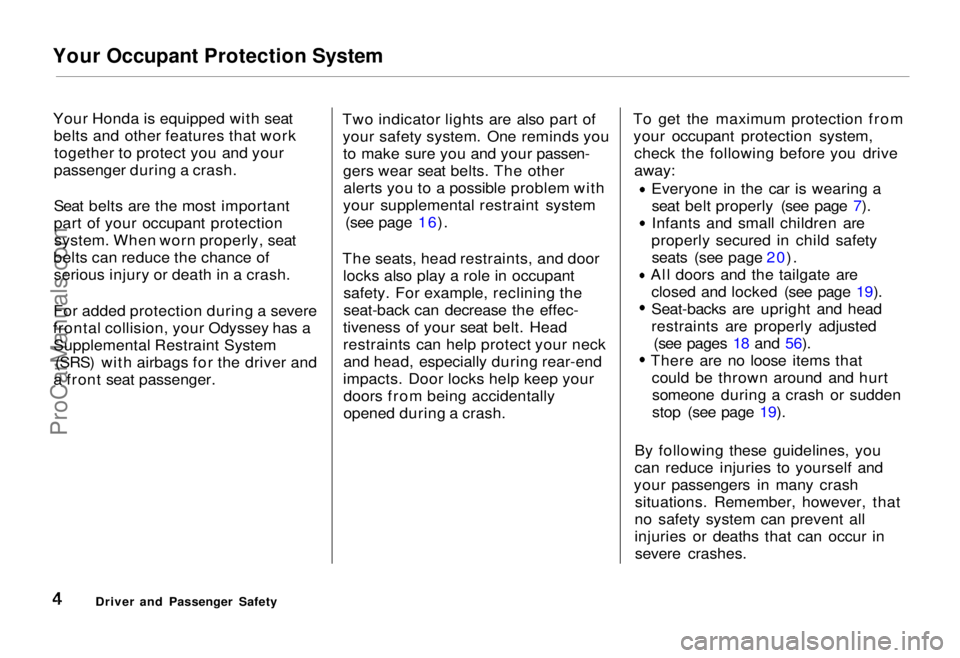
Your Occupant Protection System
Your Honda is equipped with seat belts and other features that worktogether to protect you and your
passenger during a crash.
Seat belts are the most important
part of your occupant protection system. When worn properly, seat
belts can reduce the chance of serious injury or death in a crash.
For added protection during a severe
frontal collision, your Odyssey has a Supplemental Restraint System (SRS) with airbags for the driver and
a front seat passenger. Two indicator lights are also part of
your safety system. One reminds youto make sure you and your passen-
gers wear seat belts. The otheralerts you to a possible problem with
your supplemental restraint system (see page 16).
The seats, head restraints, and door locks also play a role in occupantsafety. For example, reclining the
seat-back can decrease the effec-
tiveness of your seat belt. Head
restraints can help protect your neck and head, especially during rear-end
impacts. Door locks help keep your doors from being accidentally
opened during a crash. To get the maximum protection from
your occupant protection system, check the following before you drive
away:
Everyone in the car is wearing aseat belt properly (see page 7). Infants and small children are
properly secured in child safety seats (see page 20). All doors and the tailgate are
closed and locked (see page 19). Seat-backs are upright and head
restraints are properly adjusted
(see pages 18 and 56).
There are no loose items that could be thrown around and hurtsomeone during a crash or sudden
stop (see page 19).
By following these guidelines, you
can reduce injuries to yourself and
your passengers in many crash situations. Remember, however, that
no safety system can prevent all
injuries or deaths that can occur in severe crashes.
Driver and Passenger SafetyProCarManuals.comMain Menu Table of Contents s t
Page 6 of 240

The Seat Belt System and How It Works
Why Wear Seat Belts Wearing seat belts, and wearing them properly, is fundamental to
your safety and the safety of your
passengers.
During a crash or emergency stop,
seat belts can help keep you from
being thrown against the inside of
the car, against other occupants, or
out of the car.
Of course, seat belts cannot com-
pletely protect you in every crash.
But, in most cases, seat belts reduce
your chance of serious injury. They can even save your life. That is why
many states and all Canadian pro-
vinces require you to wear seat belts. Important Safety Reminders
Seat belts are designed for adults
and larger children. All infants and
small children must be properly
restrained in child safety seats (see
page 20).
Never let passengers ride in the
cargo area or on top of a folded-down seat. Carry passengers in the rear
only when they are sitting in a locked,
upright seat, and are properly
restrained by seat belts.
Passengers should not stand up or
change seats while the vehicle is
moving. If they are not wearing seat
belts during a crash or emergency stop, they can be thrown against the
inside of the vehicle, against other
occupants, or out of the vehicle.
A pregnant woman needs to wear a seat belt to protect herself and her
unborn child (see page 10).
Two people should never use the same seat belt. If they do, they could
be very seriously injured in a crash.
Do not place the shoulder portion of
a lap/shoulder belt under your armor behind your back. This could
increase the chance of serious
injuries in a crash.
Do not put shoulder belt pads or other accessories on seat belts. They
can reduce the effectiveness of the
belts and increase the chance of
injury.
Driver and Passenger Safety
Not wearing a seat belt
increases the chance of being
killed or seriously hurt in a
crash.
Be sure you and your
passengers always wear seat
belts and wear them properly.ProCarManuals.comMain Menu Table of Contents s t
Page 7 of 240
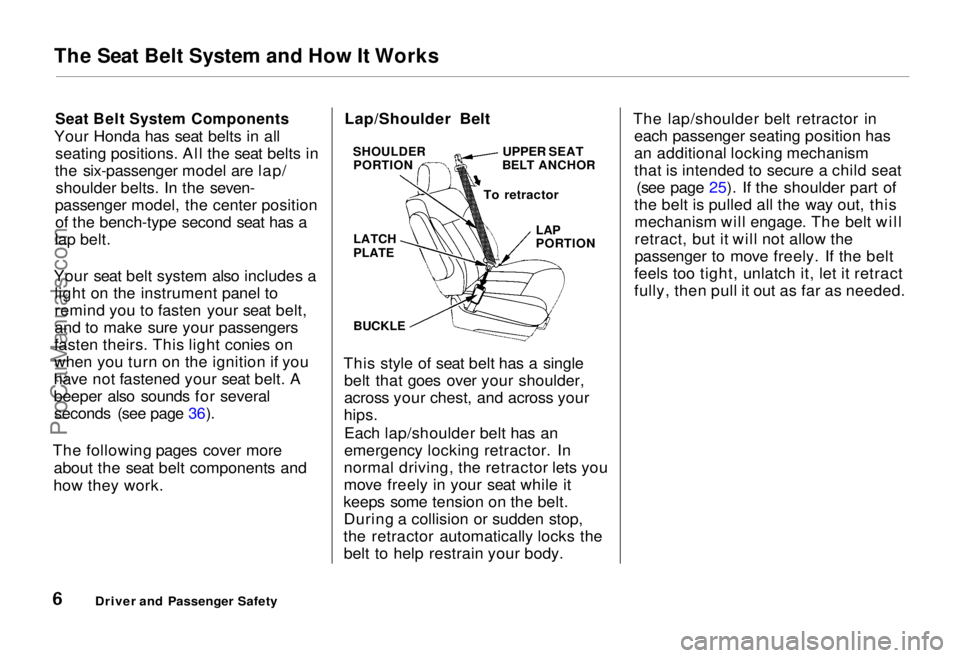
The Seat Belt System and How It Works
Seat Belt System Components
Your Honda has seat belts in all seating positions. All the seat belts in
the six-passenger model are lap/ shoulder belts. In the seven-
passenger model, the center position of the bench-type second seat has a
lap belt.
Your seat belt system also includes a light on the instrument panel to
remind you to fasten your seat belt,
and to make sure your passengers
fasten theirs. This light conies on
when you turn on the ignition if you
have not fastened your seat belt. A
beeper also sounds for several seconds (see page 36).
The following pages cover more about the seat belt components and
how they work. Lap/Shoulder Belt
This style of seat belt has a single belt that goes over your shoulder,
across your chest, and across your
hips.
Each lap/shoulder belt has an
emergency locking retractor. In
normal driving, the retractor lets you
move freely in your seat while it
keeps some tension on the belt. During a collision or sudden stop,
the retractor automatically locks the belt to help restrain your body. The lap/shoulder belt retractor in
each passenger seating position has
an additional locking mechanism
that is intended to secure a child seat (see page 25). If the shoulder part of
the belt is pulled all the way out, this mechanism will engage. The belt will
retract, but it will not allow the
passenger to move freely. If the belt
feels too tight, unlatch it, let it retract
fully, then pull it out as far as needed.
Driver and Passenger Safety
SHOULDER
PORTION
LATCH
PLATE
UPPER SEAT
BELT ANCHOR
LAP
PORTION
BUCKLE
To retractorProCarManuals.comMain Menu Table of Contents s t
Page 9 of 240
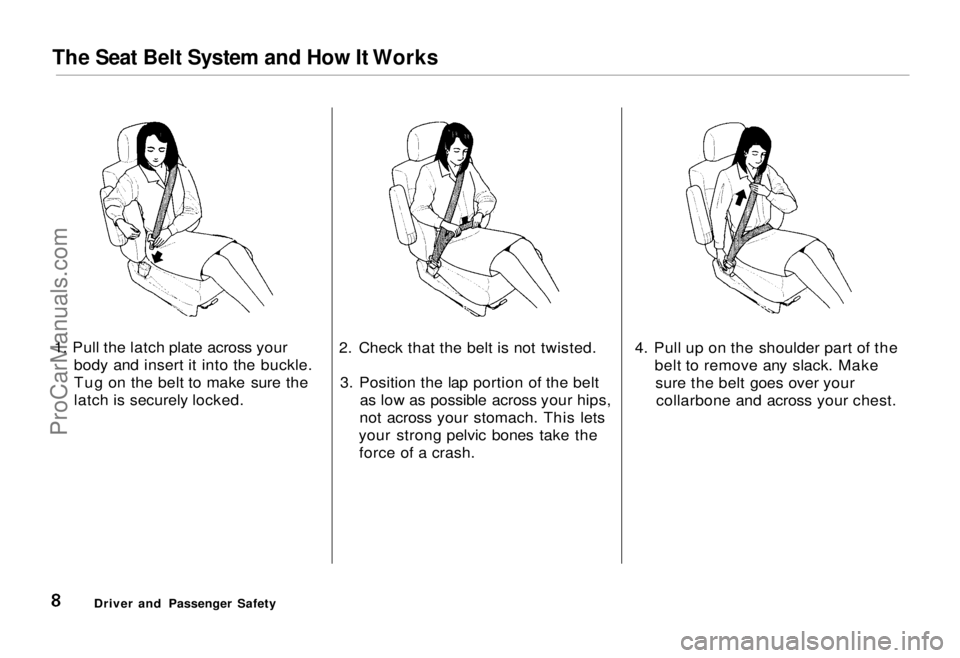
The Seat Belt System and How It Works
1. Pull the latch plate across your body and insert it into the buckle.
Tug on the belt to make sure the latch is securely locked. 2. Check that the belt is not twisted.
3. Position the lap portion of the belt as low as possible across your hips,
not across your stomach. This lets
your strong pelvic bones take the force of a crash. 4. Pull up on the shoulder part of the
belt to remove any slack. Makesure the belt goes over yourcollarbone and across your chest.
Driver and Passenger SafetyProCarManuals.comMain Menu Table of Contents s t
Page 19 of 240

Additional Safety Information
The seat belts and airbags are obvi- ously important parts of your occu-
pant protection system.
In addition, you should know that sitting upright, adjusting the head
restraint properly, locking the doors, and stowing things properly can also
increase your safety and possibly even save your life. Seat-back Position
The seat-backs should be in an upright position for you and your
passengers to get the most protec-
tion from the seat belts.
If you recline a seat-back, you reduce
the protective capability of your seat
belt. The farther a seat-back is reclined, the greater the risk that
you will slide under the belt in a severe crash and be very seriously
injured.
For information on how to adjust the
seat-back, see page 57. Head Restraint Position
Head restraints can help protect you
from whiplash and other injuries. For the best protection, adjust the top of
the restraint so it is even with the
tops of your ears, or as high as possi-
ble. For instructions on adjusting the
head restraints, see page 58.
Driver and Passenger SafetyProCarManuals.comMain Menu Table of Contents s t
Page 20 of 240
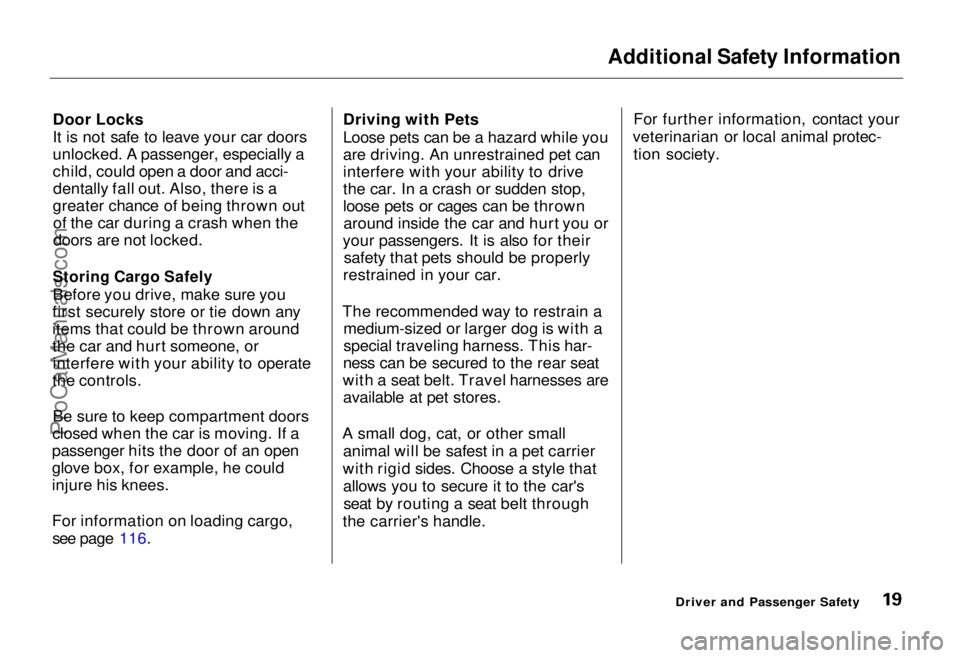
Additional Safety Information
Door Locks
It is not safe to leave your car doors
unlocked. A passenger, especially a
child, could open a door and acci- dentally fall out. Also, there is a
greater chance of being thrown out of the car during a crash when the
doors are not locked.
Storing Cargo Safely
Before you drive, make sure you
first securely store or tie down any
items that could be thrown around
the car and hurt someone, or interfere with your ability to operate
the controls.
Be sure to keep compartment doors
closed when the car is moving. If a
passenger hits the door of an open
glove box, for example, he could
injure his knees.
For information on loading cargo,
see page 116. Driving with Pets
Loose pets can be a hazard while you
are driving. An unrestrained pet can
interfere with your ability to drive
the car. In a crash or sudden stop,
loose pets or cages can be thrown
around inside the car and hurt you or
your passengers. It is also for their safety that pets should be properly
restrained in your car.
The recommended way to restrain a medium-sized or larger dog is with a
special traveling harness. This har-
ness can be secured to the rear seat
with a seat belt. Travel harnesses are available at pet stores.
A small dog, cat, or other small animal will be safest in a pet carrier
with rigid sides. Choose a style that allows you to secure it to the car'sseat by routing a seat belt through
the carrier's handle. For further information, contact your
veterinarian or local animal protec- tion society.
Driver and Passenger SafetyProCarManuals.comMain Menu Table of Contents s t
Page 22 of 240
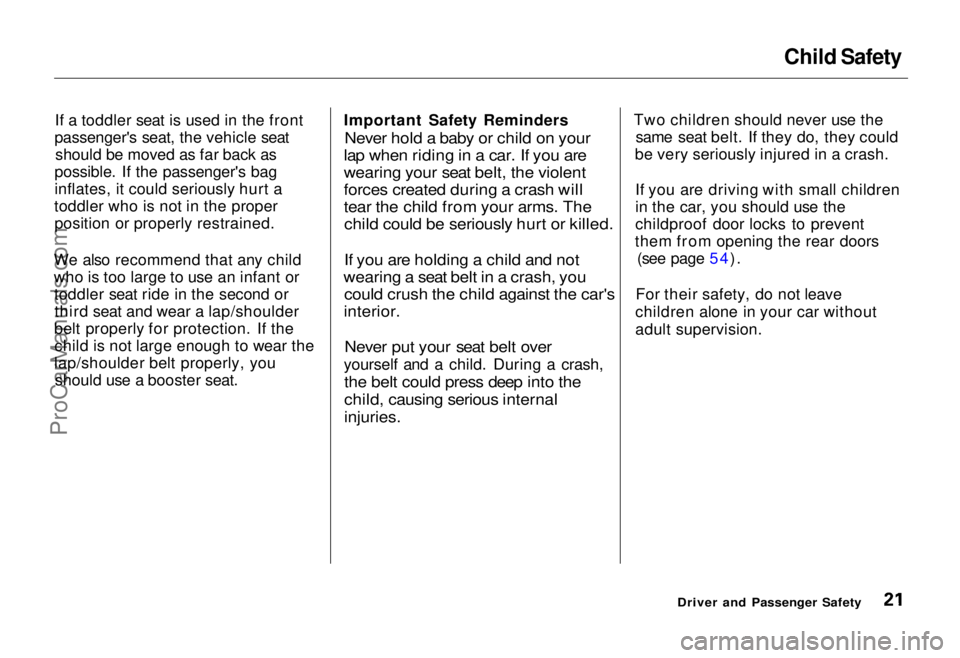
Child Safety
If a toddler seat is used in the front
passenger's seat, the vehicle seat should be moved as far back as
possible. If the passenger's bag
inflates, it could seriously hurt a
toddler who is not in the proper position or properly restrained.
We also recommend that any child
who is too large to use an infant or toddler seat ride in the second orthird seat and wear a lap/shoulder
belt properly for protection. If the child is not large enough to wear the
lap/shoulder belt properly, you should use a booster seat. Important Safety Reminders
Never hold a baby or child on your
lap when riding in a car. If you are
wearing your seat belt, the violent
forces created during a crash will
tear the child from your arms. The child could be seriously hurt or killed.
If you are holding a child and not
wearing a seat belt in a crash, you could crush the child against the car's
interior.
Never put your seat belt over
yourself and a child. During a crash,
the belt could press deep into the
child, causing serious internal
injuries.
Two children should never use the
same seat belt. If they do, they could
be very seriously injured in a crash.
If you are driving with small children
in the car, you should use the
childproof door locks to prevent
them from opening the rear doors (see page 54).
For their safety, do not leave
children alone in your car without
adult supervision.
Driver and Passenger SafetyProCarManuals.comMain Menu Table of Contents s t